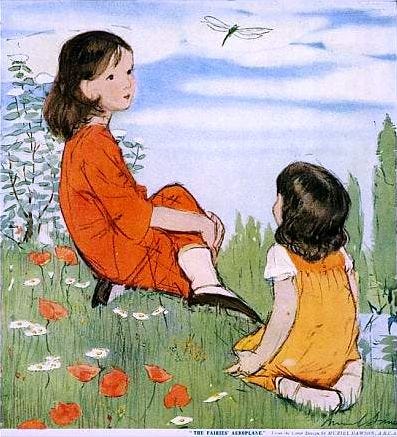Pay Attention
"Always be on the look out for the presence of wonder." E.B. White
(Art by Muriel Dawson)
I introduced my class to the art of Georgia O’Keefe by repeating her words, “Nobody really sees a flower - really - it’s so small it takes time. . .” Every one of of the kids declared that they could see a flower. To see how true their words were, I showed them two blooms: one from one of my azalea bushes and the other from my rhododendron bush.
“What color is this?” I asked them about the azalea bloom.
“Pink,” they decided.
“And the rhododendron bloom?”
“Pink,” the repeated.
Yet when I passed the flowers among them and told them to really pay attention to the blossoms, I began to hear with the rhododendron blossom that it was a light purple with yellow.” The azalea was “Pink with darker pink on the inside.”
Now we had been discussing parts of a flower so I said, “No one mentioned the way the stamens curve upward or that the yellow looks as if someone simply touched the bloom as if with an artist’s brush. That there are shades of gentle purple on the rhododendron bloom. How there are hints of a soft white. The way that the petals have small folds and curves.” The more I pointed out, the more they began to see.
We had studied the poet Mary Oliver whose instructions for living a life are:
Pay attention. Be astonished. Tell about it.
Many of these kids are raised by screens. They are filled with the quick images of YouTube and TikTok. They can name celebrities and Pokemon characters but not the names of flowers or trees or birds. The philosopher Ludwig Wittgenstein once wrote, “The limits of my language means the limits of my world.” Their worlds are shrinking to Fortnite and Roblox.
Before we went out to recess that day, I told them, “We are not going straight to the playground. We are all going to walk the track at least twice. I want you to walk, not run, and pay attention. See at least one thing you have not noticed before. This means you are going to have to really look, really listen, really be present to the world around you.”
At first they groaned, but, once outside, they undertook the assignment with relish. When they began to look, they no longer saw this as educational or a lesson. It was a game to delight in . It was all revelatory.
Some noticed a large chunk of concrete. Some spotted the bright yellow blossoms of the dandelions that they described as “small, bright yellow suns.” One spotted a Mockingbird sitting on a sign. I told them it was a Mockingbird and how one can mimic up to 200 different sounds. Now they looked at this bird differently.
One little boy noticed the cool shade of the old oak tree with its twisted root systems. “I just noticed how I feel peaceful under its branches,” he told me. “I like how the sunlight comes through the leaves.” When I told him that the Japanese have a word for this, “Komorebi - it means ‘sunlight leaking through the leaves,” he repeated the word with a smile on his face.
Another boy noticed three birds. I pointed out that they were two Robins chasing a Red-tailed hawk from their nest to protect their young. Now these were not just “birds” but had names to them. These birds became more real.
This was all revelatory and exciting to know names and a bit more of the world about them.
“That kind of deep attention that we pay as children,” botanist and author Robin Wall Kimmerer wrote, “is something that I cherish, that I think we all can cherish and reclaim, because attention is that doorway to gratitude, the doorway to wonder. The doorway to reciprocity.”
Keep reading with a 7-day free trial
Subscribe to Begin In Wonder Substack to keep reading this post and get 7 days of free access to the full post archives.


